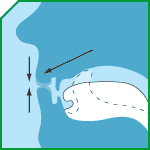
How to Play: The Trumpet Note
By playing with the lips tighter than the relaxed low note, it is possible to play higher notes, like those of a trumpet. While it is possible on many yidaki to play a bugle-like series of these notes, each higher than the last, Yolŋu only use the first of these trumpeted notes, or horn tones, in their playing. In some cases it is sustained as an introduction to a song and cue for dancers that the song is about to start. But again, only the first trumpet note. Playing any higher notes may result in the giggling of Yolŋu children!
The trumpeted note is used in almost all Yolŋu songs, often in quick alternation with the lower note, to cue changes or endings of songs. Yolŋu yidaki players are reknowned among the didjeridu world for their ability to quickly utilize these trumpeted notes in their playing. The quick horn tone is often played sort of like saying, “doop,” although more correctly in Yolŋu language, it’s “dup.” The use of the tongue to push the air, along with a pulse of air from the lungs, creates the additional air needed for the higher sound, and moving the lips to the “p” shape tightens them for the additional air pressure required. Listen to this example of Djalu’ using quick alternation of drone and horn tone.

Milkayŋu used the syllable “pu” after the “dup” to transition from the trumpeted note back to the drone.
dup-pu dhirrl dhirrl dup-pu dhirrl dhirrl
dup-pu dhirrl dhirrl
“Pu” is also used to create isolated, sustained trumpeted notes which occur in the middle of some songs but are used as a sort of call to ceremony at the beginnings of other songs. You will hear Djambawa and Milkayŋu play these sustained notes on the upcoming page about the Dhaḏalal.







